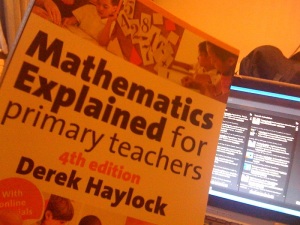How does your school organise their mathematics curriculum? There are broadly two ways of doing this. You could, in a three term year, divide the content equally between each term and teach a third in the Autumn term, a third in the Spring term and the final third in the Summer term. Or you could teach each domain of maths in more depth, sequentially going through them during the year and not revisiting them.
Here are three different models that all have their strengths and weaknesses.
1. The Scattergun Coverage Model by Hamilton Trust.
I’m not entirely sure how this model was planned, except that it seems to have covered all the objectives throughout the year.

This little extract informs teachers in which weeks they will be visiting different objectives. In my school, with the amount of work required to adopt the new curriculum, we thought this would do us fine, but actually what happened (as I’ve written) was that teachers did not take ownership of their planning and instead merely delivered the lessons they found in the order they were given. The outcome was that, whilst individual lessons were often good, the units (a week or fortnight of lessons) were often aimless with no sense of the children being on a learning journey. Maths only happened in the maths lesson and was very much isolated from the rest of the curriculum.
Much of this was my fault. As the maths leader I hadn’t taken responsibility for the planning that teachers had adopted. I’m sure many schools can make the Hamilton Trust plans work for them, but for us it had led to failure and so we needed a change.
2. The year-long blocked approach by White Rose Maths Hub
It’s too late to adopt this now, but you could plan to take it on for September.

As you’ll see from the picture, all the number and calculation objectives are taught by the end of Week 9 Spring term, and in much longer blocks than we have used in the past, enabling children to learn concepts with a much greater depth. I think this model will work brilliantly, and I’m currently discussing with the staff whether to adopt it for the next academic year. This maths hub have created tests for their medium term plans so you can assess how well the children are getting on. You can sign up for their free resources here.
3. The Term-by-Term approach (by me)
This approach was recommended to me by a headteacher who was part of the first peer review we had after our not-brilliant Ofsted. She said that I should base my plans on the 1999 schemes of work. So I went back to them and found them still hosted on a website in Dudley. Then I used a document that I only have a paper copy of called the ‘Steps Up’. I believe this was created by a group of Birmingham mathematics SLEs and provides some useful guidance as to what are the steps up to achieving the age-related expectations in each year group.
The model I went for was for the teachers to visit each domain during a term. They would cover all the content by the end of the Spring term (half in the Autumn term, the other half in the Spring term) and then use the Summer term to consolidate the age-related expectations.
My medium term plans are here:
You’ll see that they are not quite finished yet. I haven’t written the Summer Term, nor have I completed the mental maths part of the plans – what you see in the mental maths part are still the old expectations from 1999.
Finally, I made some tests for the plans. These tests are half termly and I used Testbase to make them – a paid for service that hosts all the test questions asked of children in the England’s testing system for the past 20 years. You can find the tests here in their own folder.
You may consider it quite an effort to write a whole load of medium term plans. But it’s given me a much better insight into the new curriculum and a much greater sense of ownership over what we are teaching at my school. The problem with using other people’s plans, is that you end up believing the lie that you shouldn’t have to reinvent the wheel, when actually the process of reinvention is healthy all by itself.








